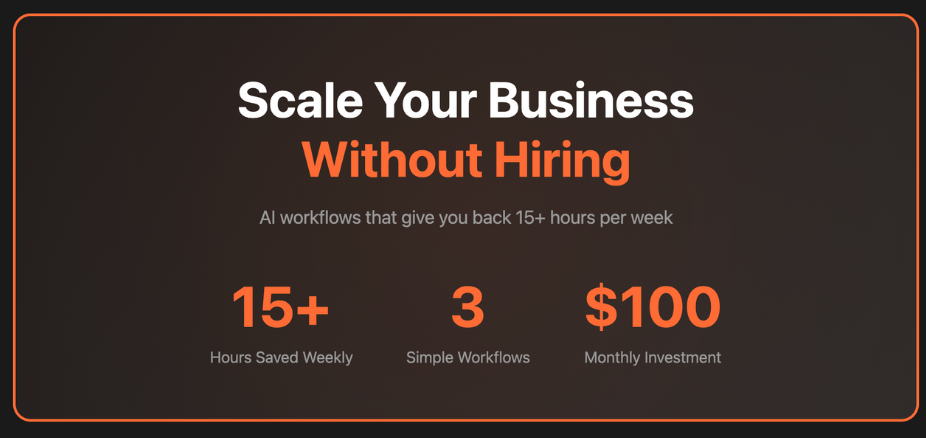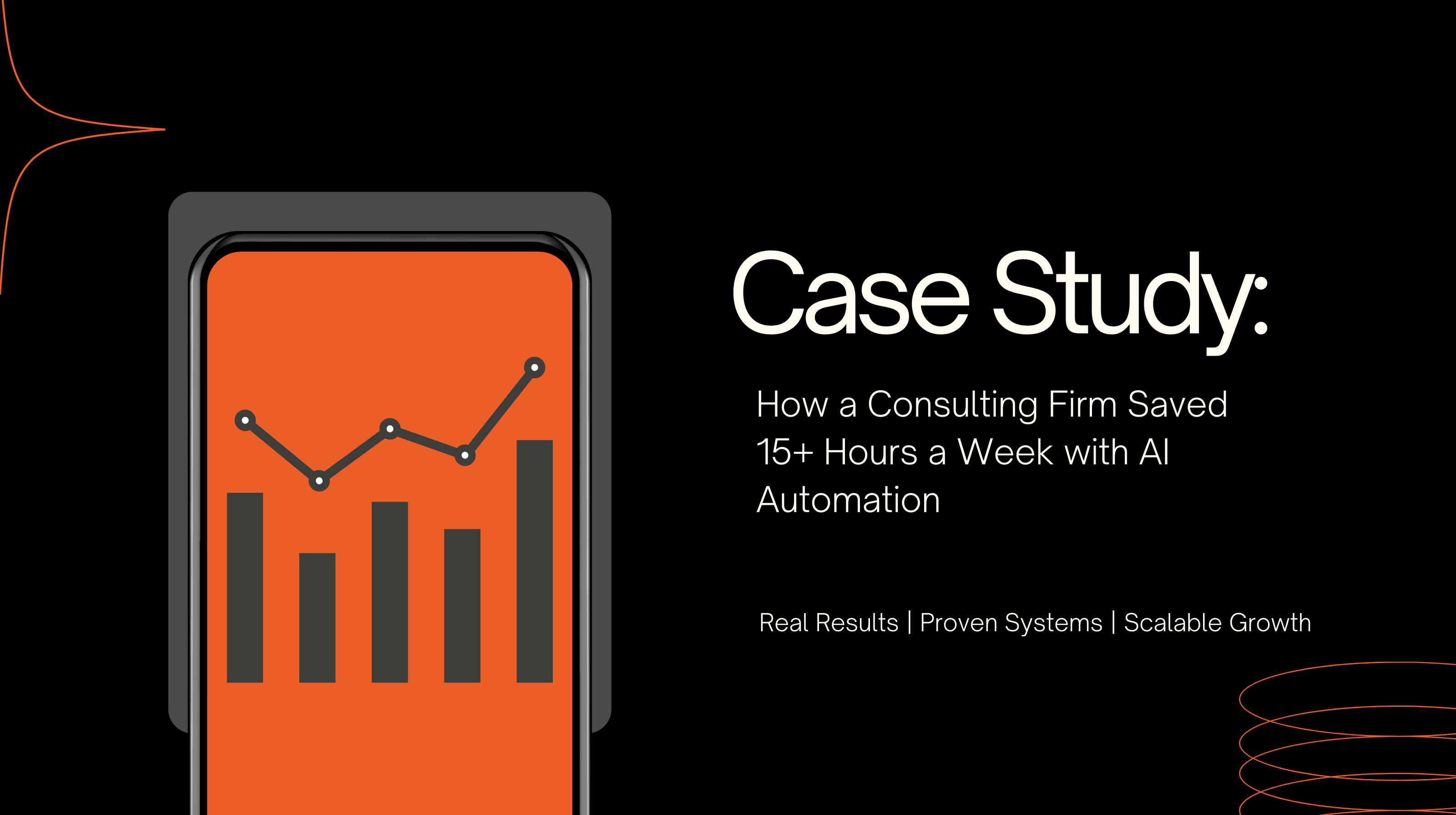AI-powered real-time workflow reporting is transforming how businesses manage data and make decisions. By automating repetitive tasks, analyzing vast datasets instantly, and presenting actionable insights, AI allows companies to operate faster and more efficiently. Here’s what you need to know:
AI-driven reporting isn’t just about speed; it’s about smarter operations that reduce errors and improve outcomes. From predictive analytics to automated dashboards, AI tools are reshaping industries and setting new benchmarks for productivity and efficiency.
AI-Powered Business Performance Reporting Automation with n8n & Gemini 2.5 | Full Workflow Tutorial
Core Benefits of AI-Driven Real-Time Reporting
Switching from traditional reporting to AI-powered systems isn't just a tech upgrade - it's a game-changer for speed, efficiency, and scalability. Businesses adopting AI-driven real-time reporting are seeing faster decision-making, smoother operations, and the ability to scale like never before.
Better Decision-Making with Real-Time Insights
AI's ability to process massive amounts of data in seconds means businesses get actionable insights in real time. Unlike human analysts, AI can sift through complex data patterns without missing a beat, offering recommendations based purely on data, free from human biases .
The impact is already visible across industries. Netflix uses AI to tailor content recommendations, Uber predicts demand and matches drivers accordingly, and Amazon Go has revolutionized shopping with its checkout-free stores powered by computer vision and deep learning. By 2025, AI is projected to be at the heart of decision-making processes in nearly every industry.
These lightning-fast insights don’t just inform decisions - they also supercharge operational efficiency.
Increased Efficiency and Productivity
AI-driven reporting doesn’t just save time - it transforms how work gets done. Generative AI has been shown to boost task throughput by 66%. Customer support agents using AI handle 13.8% more inquiries per hour, professionals create 59% more documents, and programmers complete 126% more projects weekly. Even the least efficient support agents have improved their productivity by 35%, and AI-powered training has cut new agent onboarding time from eight months to just two.
The benefits extend beyond individual tasks. For example, one company automated its loan processing, slashing turnaround time from five days to just six hours, tripling its capacity, and achieving 94% accuracy. Another organization reduced email volume during negotiations by 95% and cut negotiation timelines by 70%. AI also enables project managers to prepare documentation 30% faster and create project kick-off presentations 60% quicker. In some cases, companies have automated the creation of thousands of standard operating procedures, reducing the time needed from an hour to just 10 minutes per procedure.
With these time savings and productivity gains, businesses can respond quickly to challenges and opportunities as they arise.
Scalability and Error Reduction
AI doesn’t just make processes faster - it makes them scalable. AI-driven reporting allows organizations to handle increased workloads without needing more staff or resources. For instance, an e-commerce company implemented an AI-powered order processing system that scaled effortlessly during its annual sale, managing 15 times the usual order volume while maintaining 99.8% accuracy.
Error reduction is another major perk. AI systems apply consistent logic and trained models, eliminating the variability that comes with human processing. A healthcare provider, for example, automated its medical coding and billing, cutting costs by 42% and improving accuracy from 91% to 99.3%. Similarly, a manufacturing company using AI-driven quality control decreased defect rates by 27% and processed inspection data 15 times faster than human inspectors.
AI also excels at spotting anomalies and making real-time adjustments to prevent disruptions. A logistics company, for instance, deployed AI for route optimization. The system continuously updates delivery schedules based on live traffic, weather, and order priorities, making over 10,000 routing decisions daily without human input. This reduced delivery times by 22%, cut fuel costs by 18%, and improved on-time delivery rates to 97.5%.
Across industries, AI-powered automation has sped up processes by as much as 40%, improved overall efficiency by 30–40%, and boosted worker performance by nearly 40% . Compliance processes have also seen dramatic improvements. One financial institution’s AI-powered compliance system now reviews 100% of transactions in real time, reducing violations by 91% and cutting audit prep time from weeks to mere hours.
Key AI Technologies for Real-Time Workflow Reporting
AI-driven real-time reporting thrives on three core technologies that transform raw data into insights you can act on. These technologies cover everything from predicting trends to automating detailed reports, making them indispensable for modern workflow management. Together, they create a seamless reporting system that improves decision-making and operational efficiency.
Machine Learning for Predictive Analytics
Machine learning is at the heart of predictive analytics, uncovering patterns in large datasets to forecast future outcomes. These algorithms learn from historical data, enabling organizations to predict events with impressive precision.
"Predictive analytics is a branch of advanced analytics that makes predictions about future outcomes using historical data combined with statistical modeling, data mining techniques and machine learning." - IBM
Unlike traditional methods, machine learning handles complex relationships that defy standard mathematical models. Neural networks, for instance, excel at interpreting intricate data patterns, helping businesses anticipate workflow bottlenecks, resource needs, and potential issues before they escalate.
Take Geisinger Health, for example. In July 2022, they applied predictive analytics to over 10,000 patient records of those diagnosed with sepsis. Their machine learning model accurately forecasted patient survival rates, aiding critical healthcare decisions.
The growing reliance on AI is reflected in market trends. Gartner estimates the AI software market will soar to $297.9 billion by 2027, up from $124 billion in 2022, with a compound annual growth rate of 19.1%. Additionally, 79% of corporate strategists see AI, analytics, and automation as key drivers of business success within the next two years.
While machine learning focuses on predicting trends, Natural Language Processing (NLP) ensures these insights are communicated clearly.
Natural Language Processing for Report Automation
Natural Language Processing (NLP) turns unstructured data into concise, automated reports. It simplifies routine reporting tasks and delivers real-time alerts and summaries, keeping stakeholders informed without manual intervention.
In one study, the Regenstrief EXtraction tool (REX) achieved near-perfect results when analyzing over 64,554 reports containing MRSA-related keywords. It correctly identified 39,491 positive cases out of 39,508, with only 74 false positives, demonstrating the power of NLP in handling large-scale data with precision.
For industries with strict compliance requirements, NLP automatically categorizes and analyzes documents to meet regulatory standards. It also scans emails and communication logs to detect potential compliance issues, while monitoring legal databases for regulatory updates. Advanced features like Semantic Role Labeling further enhance the clarity of actions and relationships within text, making automated reports even more meaningful.
To complement these capabilities, custom automation tools and dashboards provide the flexibility and control modern businesses need.
Custom Automation Tools and Dashboards
AI-powered dashboards and automation tools act as the nerve center for real-time workflow reporting, offering a clear overview of operations. These tools help teams stay aligned, optimize resource use, and make informed decisions.
Custom AI tools handle tasks like data entry, document sorting, email responses, and approvals, significantly speeding up processes - sometimes by as much as 40% - and reducing costs. Through APIs, these systems maintain data continuity while learning from past data and user behavior to refine workflows over time. They also detect anomalies and suggest instant corrections, reducing disruptions and boosting productivity.
These dashboards do more than just display data; they actively guide decision-making. They provide real-time insights into process status, performance metrics, and risks, enhancing transparency and accountability. To maximize effectiveness, organizations often start with small pilot projects to test AI integration before scaling up. Customizing dashboards with relevant data, filters, and charts ensures they align with team workflows and deliver maximum value.
Looking ahead, AI-driven automation could increase productivity by up to 40% by 2030, making these tools indispensable for staying competitive in any industry.
sbb-itb-d7ea0c6
Real Applications and Use Cases in U.S. Business Operations
AI-driven reporting has evolved into a game-changer for U.S. businesses, driving improvements across various industries. From retail giants fine-tuning inventory management to healthcare systems improving compliance, these technologies are delivering measurable results that directly impact profits. Below are some real-world examples of how businesses are using AI to streamline operations, cut costs, and enhance customer experiences.
Retail and E-Commerce
Retailers have widely adopted AI-powered reporting to create more efficient and profitable operations. A 69% increase in annual revenue and 72% decrease in operating costs have been reported among retailers leveraging AI. These gains come from AI's ability to process large volumes of customer data and turn them into actionable insights.
Snow, a direct-to-consumer brand, used Rep AI to automate abandoned cart conversations, achieving a 33.85% conversion rate and recovering over $220,000 in revenue. An impressive 98.34% of interactions were automated.
Similarly, Uprising Foods deployed Rep AI to handle subscription support, boosting their conversion rate from 3% to over 5% and increasing profitability by 21.5% while reducing support requests.
Volcom streamlined its product content creation with Hypotenuse AI, cutting the time required for product reviews to just 1-2 minutes per product, saving around 140 hours per season. Meanwhile, ADA's LEGEAR Division doubled its Return On Ad Spend (ROAS) from 9x to 17x and reduced the time needed for new product launches by over 95%.
"CommerceIQ has enabled my team to operate at the pace needed to win in the market. Issues that would take weeks to identify are now being flagged and resolved on the same day."
Inventory management is another area seeing major improvements. A global luxury fashion brand used Impact Analytics' InventorySmart solution to cut inventory costs by 10% and increase SKU availability by 12%, improving in-season sell-through rates.
Finance and Healthcare Compliance Reporting
Navigating healthcare regulations is a constant challenge, with compliance costing the industry more than $39 billion annually. On top of that, 56% of healthcare compliance leaders report insufficient resources to keep up with changing rules.
AI-powered compliance systems are stepping in to address these issues. Major U.S. hospital networks using AI-assisted monitoring achieved a 60% reduction in documentation errors and a 40% drop in compliance incidents within a year. Audit preparation times were also slashed by 70% thanks to predictive analytics.
"Managing healthcare compliance is a continuous investment of time and talent, complicated further by ever-changing regulations, internal systems, and technology. When AI is integrated into the process, it enables real-time compliance monitoring for team members."
Perla, a HealthTech provider, developed an AI-powered compliance management system for long-term care facilities. This system is projected to cut administrative workloads by 40%, ensuring HIPAA compliance while scaling to 1,000 institutions and 500,000 users. Nearly 75% of healthcare and life sciences organizations are already using or planning to use AI for compliance, risk assessments, and administrative tasks.
Logistics and Supply Chain Management
The logistics sector, responsible for 11-12% of global carbon emissions, is under pressure to optimize operations while reducing environmental impact. AI-powered monitoring systems are helping companies tackle both challenges.
For instance, Optimized Courier used Tive trackers to prevent temperature excursions on critical shipments. Real-time alerts allowed them to save a vaccine shipment before its temperature stability was compromised, avoiding millions in losses. Today, 97% of their shipments use Tive trackers.
Alpine Fresh saw similar benefits, using Tive's Solo 5G trackers to monitor perishable goods. They saved a $120,000 blueberry shipment and a $90,000 asparagus shipment by making real-time adjustments.
AI-powered tools also improve efficiency across the board. Predictive analytics can reduce inventory costs by up to 50%, while route optimization can cut fuel usage by 15%. Early adopters of these technologies report 15% lower logistics costs and a 35% reduction in inventory levels.
Customer expectations are also driving adoption. 64% of customers now expect real-time tracking, and 82% want proactive updates on their orders. Even a 5% boost in customer retention through better visibility can lead to a 25-95% increase in profits.
"When using Tive, Optimize has never lost a shipment, temperature excursions have gone all but extinct, and we have been able to ensure that life-saving treatments, disease-eradicating research, and life-giving organs safely arrive at the correct temperature - and are viable for patient use."
The use of IoT devices for shipment tracking has grown rapidly, from 25% of companies in 2023 to 53% in 2024, with another 25% planning implementation within a year.
Devcore's Leverage Blueprint™ for Custom AI Solutions

While many businesses benefit from off-the-shelf solutions, custom approaches like Devcore's Leverage Blueprint™ provide tailored AI strategies for unique challenges.
The Leverage Blueprint™ process starts with a detailed workflow audit to identify inefficiencies and areas where AI can make the biggest impact. This includes analyzing data flows, communication patterns, and time-consuming manual tasks. The goal is to focus on business outcomes rather than just implementing technology.
Devcore's automation tools address common challenges such as CRM updates, email responses, call summaries, data entry, and lead research. Their AI-powered systems, including research agents, lead matching tools, and content generators, integrate seamlessly with existing processes.
To complement these tools, Devcore also offers technical development services like API integrations, custom dashboards, and workflow optimization tools. These solutions provide real-time visibility into operations, ensuring that AI enhances rather than disrupts workflows.
Pricing for Devcore's services ranges from $1,200/month for smaller implementations to $15,000/month for comprehensive solutions. Each package includes strategy sessions and workflow audits to ensure businesses see measurable returns on their investment.
Implementation Strategies and Best Practices
Implementing AI-powered real-time workflow reporting isn’t just about buying software - it’s about careful planning, execution, and ongoing refinement. To truly maximize the value of AI in your workflows, you need a structured approach that ties technology to your business goals while preparing your teams for change.
Here’s how to set the stage for success.
Preparing Your Business for AI-Powered Reporting
Before jumping into AI adoption, you need to lay a solid foundation. A key starting point? Data readiness. Your data needs to be accurate, complete, and consistent across the board. Conduct a data readiness assessment to identify gaps and inefficiencies, such as repetitive tasks or manual data entry, that AI can help streamline.
Many businesses find their data is siloed, making it difficult for AI systems to deliver meaningful insights. For example, Aberdeen City Council projected a 241% ROI and annual savings of $3 million by using Microsoft 365 Copilot. Their success was rooted in thorough planning and clear goal-setting before implementation.
Once your data is assessed, it’s time to clean it up. Deduplicate, standardize, and automate quality checks. Establish clear protocols for data security, sharing, and metadata management. As Benjamin Kennady, Cloud Solutions Architect at Striim, puts it:
"The capability of a company to make the best decisions is partly dictated by its data pipeline. The more accurate and timely the data pipelines are set up allows an organization to more quickly and accurately make the right decisions."
Equally important is workforce preparation. Be transparent with employees about your AI goals and address any concerns early. Offer training programs that cover both technical skills, like AI tools and data analysis, and soft skills, such as critical thinking and adaptability.
Centralizing your data is another critical step. Connecting disparate sources into a single source of truth ensures AI systems aren’t working with incomplete or conflicting information. Also, set up backup systems to minimize disruptions during the transition.
With these preparations in place, the focus shifts to selecting the right AI tools.
Choosing Custom AI Solutions
Picking the right AI solution involves balancing functionality, integration, and scalability. Start with use cases that can deliver quick wins and immediate value.
When evaluating platforms, prioritize ease of use and seamless integration with your existing systems. Look for features like predictive analytics or natural language processing that align with your specific needs. The tool should also scale effectively as your operations grow.
A great example is the British Columbia Investment Management Corporation (BCI). By carefully selecting tools tailored to their workflows, they increased productivity for 84% of Copilot users by 10% to 20% and improved job satisfaction by 68%, saving over 2,300 person-hours.
Security and compliance should never take a backseat. Ensure the tools you choose offer robust data privacy protections, such as end-to-end encryption and access controls based on the principle of least privilege. Active monitoring with detailed logs can also help identify potential issues quickly.
Before committing, test tools in live environments to evaluate their performance under real-world conditions. Bring together data engineers, IT staff, and business leaders to ensure the solution meets both technical and operational needs.
As Jepson Taylor, an AI expert, advises:
"Find the low-hanging fruit that's delicious, [with a] project that's very feasible, high value. Know your industry, get a few wins."
Start small by automating a single process where AI can make an immediate impact. For instance, Lumen reduced interaction summarization time from four hours to 15 minutes using Microsoft Copilot, saving an estimated $50 million annually.
Lastly, define clear roles for humans and AI. Use explainable AI tools to maintain transparency and accountability, and focus on combining AI’s strengths in data processing with human judgment for decision-making. As Thomas W. Malone from MIT Sloan explains:
"Combinations of humans and AI work best when each party can do the thing they do better than the other."
Once your AI solution is in place, the next step is measuring its impact.
Measuring ROI and Tracking Performance
To ensure your AI investment delivers results, you need clear metrics and tracking mechanisms. Start by setting SMART goals and establishing baseline measurements for key performance indicators (KPIs). These benchmarks will help you assess improvements and calculate ROI accurately.
Consider all costs, from development and data acquisition to training and maintenance. Many businesses see strong returns - more than 55% of retailers report an AI-driven ROI exceeding 10%.
Use dashboards to track both quantitative metrics, like time saved and error reduction, and qualitative improvements, such as employee satisfaction. For example, PayPal reported $7.3 billion in revenue for Q2 2023, up 7% year-over-year, while cutting losses by 11% thanks to AI-enhanced risk management. High-impact areas often include customer service (74%), IT operations (69%), and decision-making (66%).
Communicate results effectively with visual aids like graphs and charts to keep stakeholders informed and engaged. For example, Public Investment Corporation (PIC) achieved faster investment approvals, cutting the timeline from 12 months to 6 months using Microsoft 365 Copilot.
Plan for regular updates to your AI systems as technology evolves. Factor in potential risks, such as bias or privacy concerns, when calculating ROI. Continuous monitoring and optimization are essential. Use real-time reports to track performance and identify areas for improvement.
Beyond cost savings, consider the strategic benefits of AI, like faster decision-making and enhanced customer satisfaction. Even a modest 5% increase in customer retention can boost profits by 25% to 95%, showing the value of measuring improvements in customer-facing areas.
Conclusion: Transforming Workflows with AI
AI-powered real-time workflow reporting is reshaping how businesses operate, delivering tangible improvements across productivity, efficiency, and cost management. Companies leveraging AI in their workflow automation have reported up to 35% higher productivity and 30–40% better process efficiency.
The cost savings are equally striking. Processes that once cost $1,600 can now be reduced to just $250 with full automation. Cycle times have dropped dramatically - from 29 hours to just 2 hours in fully autonomous workflows - while accuracy rates soar to 99.9%. These advancements are not isolated to one sector; they’re happening across industries.
Take, for instance, a telecommunications provider that slashed customer resolution times from 8.5 minutes to 2.3 minutes, handling 83% of inquiries with minimal human involvement. Similarly, a financial institution achieved a 91% reduction in compliance violations with AI-powered monitoring capable of reviewing 100% of transactions in real time. These kinds of results are setting new benchmarks for what’s possible.
Another game-changer is scalability. AI systems can process massive data volumes without a corresponding rise in costs. For example, businesses have managed 15x normal order volume during peak periods while maintaining 99.8% accuracy. This isn't just about speed - it’s about creating systems that can grow and adapt seamlessly. To unlock these benefits, companies need AI solutions tailored to their specific challenges and operational frameworks.
Custom AI solutions, like those offered by Devcore, are designed to eliminate inefficiencies and scale alongside your business. Their proprietary Leverage Blueprint™ methodology ensures that AI systems are not only efficient but also aligned with your unique needs, delivering measurable outcomes.
The shift is already happening: 72% of companies are using AI in some capacity, and at least 50% of businesses are applying AI across multiple functions. The real question is no longer if AI will transform workflow reporting, but how quickly your organization can adapt to stay ahead.
Incremental changes are no longer enough. AI-driven real-time workflow reporting represents a fundamental shift toward faster, more accurate, and scalable operations. Businesses that embrace this transformation today are positioning themselves to lead in tomorrow’s competitive landscape.
FAQs
How does AI-powered real-time reporting make decision-making faster and more effective?
AI-powered real-time reporting transforms decision-making by providing immediate, data-driven insights that are both precise and actionable. Traditional methods often require lengthy manual analysis, but AI takes over by automating data processing, spotting patterns, and uncovering trends instantly.
This level of automation minimizes human error and allows businesses to react quickly to shifts and opportunities as they happen. With predictive insights at their fingertips, organizations can make quicker, more informed decisions that lead to stronger results.
What technologies power AI-driven workflow reporting, and how do they work together?
AI-powered workflow reporting integrates cutting-edge technologies to provide immediate, actionable insights. At the core are predictive analytics, which leverage pattern recognition and anomaly detection to spot trends and flag potential issues before they escalate. Alongside this, real-time data processing frameworks like Apache Beam and Spark Streaming ensure that data is continuously cleaned, validated, and updated, maintaining accuracy for reporting purposes.
Automation tools driven by AI take it a step further by instantly gathering, analyzing, and presenting data. This combination allows businesses to make quicker, more informed decisions while minimizing inefficiencies and enhancing workflow management.
What steps can businesses take to successfully implement AI-powered reporting systems and maximize their ROI?
To make the most of AI-powered reporting systems and see a solid return on investment, businesses should begin by setting clear, actionable objectives that tie directly to their overall strategy. It's smart to target high-impact use cases that can show measurable results quickly, while also ensuring that everyone on the team understands and agrees on the goals.
Another key factor is data quality. Reliable and accurate data is the backbone of any effective AI system. To keep things running smoothly, encourage collaboration between departments, monitor the system regularly, and evaluate its performance on an ongoing basis. These practices help ensure continuous improvement and long-term success. By following these steps, businesses can fully integrate AI into their reporting processes and gain meaningful insights.
Related posts
- Manual Workflows Slowing Growth? AI Solutions
- Ultimate Guide to Scaling Business with Automation
- Error Handling in AI Workflows: Challenges and Solutions
- Ultimate Guide to Custom AI Cost-Benefit Analysis
{"@context":"https://schema.org","@type":"FAQPage","mainEntity":[{"@type":"Question","name":"How does AI-powered real-time reporting make decision-making faster and more effective?","acceptedAnswer":{"@type":"Answer","text":"<p>AI-powered real-time reporting transforms decision-making by providing <strong>immediate, data-driven insights</strong> that are both precise and actionable. Traditional methods often require lengthy manual analysis, but AI takes over by automating data processing, spotting patterns, and uncovering trends instantly.</p> <p>This level of automation minimizes human error and allows businesses to react quickly to shifts and opportunities as they happen. With predictive insights at their fingertips, organizations can make quicker, more informed decisions that lead to stronger results.</p>"}},{"@type":"Question","name":"What technologies power AI-driven workflow reporting, and how do they work together?","acceptedAnswer":{"@type":"Answer","text":"<p>AI-powered workflow reporting integrates cutting-edge technologies to provide immediate, actionable insights. At the core are <strong>predictive analytics</strong>, which leverage pattern recognition and anomaly detection to spot trends and flag potential issues before they escalate. Alongside this, <strong>real-time data processing frameworks</strong> like <a href=\"https://beam.apache.org/\" target=\"_blank\" rel=\"nofollow noopener noreferrer\">Apache Beam</a> and <a href=\"https://spark.apache.org/streaming/\" target=\"_blank\" rel=\"nofollow noopener noreferrer\">Spark Streaming</a> ensure that data is continuously cleaned, validated, and updated, maintaining accuracy for reporting purposes.</p> <p>Automation tools driven by AI take it a step further by instantly gathering, analyzing, and presenting data. This combination allows businesses to make quicker, more informed decisions while minimizing inefficiencies and enhancing workflow management.</p>"}},{"@type":"Question","name":"What steps can businesses take to successfully implement AI-powered reporting systems and maximize their ROI?","acceptedAnswer":{"@type":"Answer","text":"<p>To make the most of AI-powered reporting systems and see a solid return on investment, businesses should begin by setting <strong>clear, actionable objectives</strong> that tie directly to their overall strategy. It's smart to target high-impact use cases that can show measurable results quickly, while also ensuring that everyone on the team understands and agrees on the goals.</p> <p>Another key factor is <strong>data quality</strong>. Reliable and accurate data is the backbone of any effective AI system. To keep things running smoothly, encourage collaboration between departments, monitor the system regularly, and evaluate its performance on an ongoing basis. These practices help ensure continuous improvement and long-term success. By following these steps, businesses can fully integrate AI into their reporting processes and gain meaningful insights.</p>"}}]}




